|
HOME: www.hiltonpond.org |
|||
|
All text & photos © Hilton Pond Center BARRED OWL: For the past three weeks or so nighttime has been quite noisy around Hilton Pond Center. While several groups of Coyotes assembled each evening in the moonlight to out-howl each other, a fully grown male Bullfrog called from the banks of the pond--serenading us with a gutteral call best described by "mmwonnng." Crickets rubbed their wings together rapidly to produce a series of high-pitched chirps, and occasionally we heard the mysterious sheep-like vocalization of a young Raccoon or the alarm snort of a White-tailed Deer. The most noticeable nocturnal sounds, however, have originated from trees above the old farmhouse at Hilton Pond, just above our master bedroom windows. Each night owls hooted and hollered from dusk until well past midnight--sometimes so loudly and vigorously they awakened us from sound sleep. Surprisingly, these calls have come from different owl species, meaning two kinds of owls must be occupying the same territory. The deepest hoots were made by a pair of Great Horned Owls who duet each other with a basso profundo call that sounds like "Who-Who-Who Whoo-whaa." The other owl song is more familiar to many folks: "Who cooks for you, who cooks for you all"--the unmistakable call of a Barred Owl. Surprisingly, our local Barred Owls have been highly visible in broad daylight, and on several occasions in April we spotted one of them perched on any of several limbs off not far from the back deck (see photo above).
All text & photos © Hilton Pond Center We suspect these two very dissimilar owl species were hanging around the farmhouse due to an explosion of Eastern Cottontails this spring. Most years we observe only one of these native rabbits at any given moment but in 2012 a glance out the window dawn to dusk frequently showed one to five subadults and adults munching away on herbaceous vegetation. Although Great Horned Owls, Bubo virginianus, would have no problem catching and killing a fully grown cottontail, Barred Owls, Strix varia, tend to take somewhat smaller prey--including cottontail kits. At Hilton Pond Barred Owls seem to specialize on Eastern Chipmunks that are almost exclusively diurnal, so we weren't surprised one morning this week to enter the kitchen for breakfast--only to see a Barred Owl perched in broad daylight atop one of our platform feeders (above), beneath which chipmunks often forage for spilled sunflower seeds.
All text & photos © Hilton Pond Center This Barred Owl--apparently an adult female--sat nearly motionless for a long time, allowing us to take lots of exposures through the double panes of the patio door. The owl probably could see us through the glass but based on its behavior when we approached it outside on previous occasions we suspect the bird considered us neither friend nor foe and ignored our picture-taking activity. Eventually something attracted the owl's attention and it leaned over the edge of the feeder (above) before diving to the ground and swooping upward so quickly we weren't able to capture the action with our camera. The owl had nothing in its talons and ended up on a branch about 30 feet away--just above one of our open mist nets. This position was truly good and bad news, and here's why: A couple of times last week we saw the owl unsuccessfully go after a songbird snared in one of our nets, and we didn't want this to become habit; on the other hand, there was always a possibility we could capture this big bird for banding--even though we had seen it bounce out of small-mesh nets.
All text & photos © Hilton Pond Center We kept a close eye on both owl and mist net, checking the latter every 15 seconds or so. When a little brown bird flew into the net we jumped and ran toward it but the owl was even faster, gliding down into the net shelf just below the smaller bird. Happily, the owl missed its potential prey and flipped onto its back in the baggy mesh and was caught temporarily. We quickly but carefully grasped the owl's thighs before it could lacerate us with its talons and lifted it out of the net. One must be particularly wary of a Barred Owl's strong feet and long, decurved claws that can do considerable damage. The undoubtedly surprised owl started clacking its bill and then reached out with its bill to bite down on webbing between two of our fingers. Ouch! The tip of the hooked bill drew a little blood, but being bitten by a Barred Owl is much less painful and injurious than being "footed" by one. We wrestled a while with the raptor--clutching it closely to keep it from flapping--and got it back to our office where we were able to bundle it into a towel, covering its head and wings and giving it something harmless to dig its talons into. With that, we went back out to the net to photographed and release the already banded and very lucky Carolina Wren (above) that unwittingly had served as bait for our owl.
All text & photos © Hilton Pond Center Our next task--one for which we could have used a little assistance--was getting a band onto the Barred Owl. Banding big raptors like this one presents several challenges. For one, the bander has to be ever-vigilant against getting bloodied by super-sharp talons. In addition, bands required by these birds are different from those we regularly place on passerines and hummingbirds. Songbirds and hummers take what we call a "butt band" because we simply open it and then butt together the ends to form a ring on the bird's leg (see lower band above left). However, most raptors larger than an Eastern Screech-Owl or Cooper's Hawk can use its decurved bill to pry off a butt band, so a "lock-on band" is needed. This style of band has two flanges (at top above left)--including a long one that folds over the shorter to provide a locking mechanism the bird of prey cannot remove. (Interestingly, eagles have even stronger bills that necessitate a band with two even-length flanges drilled for a pop rivet!) Some raptor banders use stainless steel butt bands that are harder to open than standard ones made of aluminum. It's hard to hold a rambunctious Barred Owl while opening and closing a lock-on band--we're sure owl-banding specialists are more adept at the practice--but we finally did get the bird banded (above right, #1387-91501) WITHOUT getting footed or nipped further. You'll note from the photo an interesting aspect of most owls: Their legs and toes are fully feathered, likely an adaptation that keeps wind from whistling across those structures and alerting prey items that winged death is on the way.
All text & photos © Hilton Pond Center While we're thinking of such things, we should also point out the special adaptation that occurs on the lead edge of the primary wing feathers of many owls. In the Barred Owl feather above, for example, barbs are separated and with flexible tips. This is another way to reduce flight noise; a knife-like wing edge would tend to make an alarming whistling noise as the predator approached in the dark.
All text & photos © Hilton Pond Center With our Barred Owl securely banded and in a relatively calm state we took a few moments to examine it further and shoot a few more photos. The image above reveals several interesting adaptations, including the loose structure of feathers on the bird's face--yet another adaptation that prevents wind-whistling when the bird dives at potential prey. Around the base of the bill we also see lots of stiff hair-like feathers called "rictal bristles." These likely function to keep the flailing legs of prey items from hitting the owl's eyes, and may also act as a sort of funnel to get the prey down the owl's gullet.
All text & photos © Hilton Pond Center In even closer view we see the structure of the owl's menacing bill, which is decurved and with upper mandible overlapping the lower. The tip of the bill isn't quite as pointed as one might expect--a super-sharp bill would tend to break easily--but it's plenty sharp enough to puncture the skin of a rodent or a careless bander. If the owl's talons haven't penetrated vital organs of a prey item and killed it outright, an owl can use its bill to snap the spine of a hapless mouse or chipmunk. At the base of the owl's bill is the cere, a somewhat softer region that surrounds the bird's nostrils. The full function of the cere is unclear but some ornithologists think its condition and color serve as a signal to a prospective mate of the bird's health; this wouldn't make a lot of sense in owls that are primarily nocturnal and whose ceres wouldn't be all that visible.
All text & photos © Hilton Pond Center In side view (above) a Barred Owl skull from the Center's collection shows the lower mandible is actually quite long, enabling the bird to open wide and swallow whole smaller prey such as mice, voles, and even frogs. For bigger mammals the owl holds tight with its talons, skins the prey, and then pulls off strips of flesh with its bill. Barred Owls occasionally do take songbirds, in which case they often just bite off the head and leave the carcass behind--perhaps because removing feathers is so painstaking a task. Since the owl engulfs small prey whole, it must eliminate bones and hair by regurgitating them as pellets--something we've looked for but never have been able to find around Hilton Pond.
All text & photos © Hilton Pond Center If you don't like pain the most frightening part of any owl, of course, is its talons (above). In a Barred Owl these claws are black and about an inch-and-a-half in length--easily long enough to penetrate and kill the bird's prey. Toes are covered by scaly tubercles that enhance grip. While we were banding the owl it kept its feet tightly closed most of the time, occasionally lashing out with one or both legs with toes open wide and ready to grab. In the photo above the owl's foot structure appears to be "anisodactyl"--three toes forward and one toe back--but it's actually "semi-zygodactyl." This means the outer toe on each foot can swing backwards, providing a two-plus-two configuration that provides a more powerful killing grip.
All text & photos © Hilton Pond Center Along with banding and photographing our newly captured owl we also took measurements to try to determine its sex. Owl species are typically monomorphic--sexes look alike--but females typically are up to 25% larger than their mates and our owl-in-hand seemed large for a Barred Owl. Turns out the bird's tail measurement was 223mm (male Barred Owls are usually 192mm-231mm, females are 207mm-257mm), while the owl's wing chord came in at 337mm (males range 308mm-340mm, females 330-357). These measurements were inconclusive but were suggestive of either a large male or a small female, so we looked for one more hint that could help us to reveal the bird's sex. Confirmation came when we blew on the bird's belly feathers, parting them so we could see a "brood patch"--a bare area of skin that was wrinkly and edematous and a sure sign the bird recently had been on eggs or brooding chicks. Barred Owl males are not known to incubate or develop a brood patch so we were now confident our newly banded owl was indeed a female. We should point out the photo above reveals a distinctive characteristic of Barred Owls that helps in identification: They and the nearly all-white Barn Owl are the only owls in the Southeastern U.S. with dark eyes; all others have yellow irises. Barred Owls also lack "ear tufts" or "horns" sported by most of our owl species.
All text & photos © Hilton Pond Center With a leg band in place and measurements, sexing, and photo documentation complete, the Barred Owl was ready for release. We were excited by an opportunity to examine this mostly nocturnal raptor up-close but were especially pleased it was new for our list of birds banded at the Center; after 31 years of study it's not often we capture a new species. With a firm left-hand grip on the owl's thighs and a right-hand hold on the camera, we walked out behind our old farmhouse and let go the bird, snapping a few shots as she spread her wings (above) and zoomed upward to perch on the branch of a big White Oak overhanging the pond. There the Barred Owl sat, looking back at us for a moment before silently sailing across the water as Hilton Pond Center's banding species #126. All contributions are tax-deductible |
|---|
 The Piedmont Naturalist, Volume 1 (1986)--long out-of-print--has been re-published by author Bill Hilton Jr. as an e-Book downloadable to read on your iPad, iPhone, Nook, Kindle, or desktop computer. Click on the image at left for information about ordering. All proceeds benefit education, research, and conservation work of Hilton Pond Center for Piedmont Natural History. The Piedmont Naturalist, Volume 1 (1986)--long out-of-print--has been re-published by author Bill Hilton Jr. as an e-Book downloadable to read on your iPad, iPhone, Nook, Kindle, or desktop computer. Click on the image at left for information about ordering. All proceeds benefit education, research, and conservation work of Hilton Pond Center for Piedmont Natural History. |
|
|
"This Week at Hilton Pond" is written and photographed by Bill Hilton Jr., executive director of Hilton Pond Center for Piedmont Natural History
|
|
|
Please refer "This Week at Hilton Pond" to others by clicking on this button:
|
Comments or questions about this week's installment? Send an E-mail to INFO. (Be sure to scroll down for a tally of birds banded/recaptured during the period, plus other nature notes.) |

Click on image at right for live Web cam of Hilton Pond,
plus daily weather summary
Transmission of weather data from Hilton Pond Center via WeatherSnoop for Mac.
|
--SEARCH OUR SITE-- For a free on-line subscription to "This Week at Hilton Pond," send us an |
|
Thanks to the following fine folks for recent gifts in support of Hilton Pond Center for Piedmont Natural History and/or Operation RubyThroat: The Hummingbird Project. Your tax-deductible contributions allow us to continue writing, photographing, and sharing "This Week at Hilton Pond." Please see Support if you'd like to make a gift of your own.
|
If you enjoy "This Week at Hilton Pond," please help support Hilton Pond Center for Piedmont Natural History. It's painless, and YOU can make a difference! (Just CLICK on a logo below or send a check if you like; see Support for address.) |
|
Make credit card donations on-line via Network for Good: |
|
Use your PayPal account to make direct donations: |
|
If you like shopping on-line please become a member of iGive, through which 950+ on-line stores from Amazon to Lands' End and even iTunes donate a percentage of your purchase price to support Hilton Pond Center.  Every new member who registers with iGive and makes a purchase through them earns an ADDITIONAL $5 for the Center. You can even do Web searches through iGive and earn a penny per search--sometimes TWO--for the cause! Please enroll by going to the iGive Web site. It's a painless, important way for YOU to support our on-going work in conservation, education, and research. Add the iGive Toolbar to your browser and register Operation RubyThroat as your preferred charity to make it even easier to help Hilton Pond Center as you shop. Every new member who registers with iGive and makes a purchase through them earns an ADDITIONAL $5 for the Center. You can even do Web searches through iGive and earn a penny per search--sometimes TWO--for the cause! Please enroll by going to the iGive Web site. It's a painless, important way for YOU to support our on-going work in conservation, education, and research. Add the iGive Toolbar to your browser and register Operation RubyThroat as your preferred charity to make it even easier to help Hilton Pond Center as you shop. |
|
BIRDS BANDED THIS WEEK at HILTON POND CENTER 27-30 April 2012 |
|
|
SPECIES BANDED THIS WEEK: * = New species for 2012 WEEKLY BANDING TOTAL 8 species 10 individuals 2012 BANDING TOTAL 14 species 247 individuals 31-YEAR BANDING GRAND TOTAL (since 28 June 1982, during which time 170 species have been observed on or over the property) 126 species (31-yr avg = 66.3) 57,335 individuals (31-yr avg = 1,850) NOTABLE RECAPTURES THIS WEEK Carolina Wren (1) All text & photos © Hilton Pond Center
|
OTHER NATURE NOTES: --The Barred Owl described in this week's photo essay was the 126th species captured at the Center since 1982. Our complete list is at Checklist of Birds Banded. All text & photos © Hilton Pond Center |


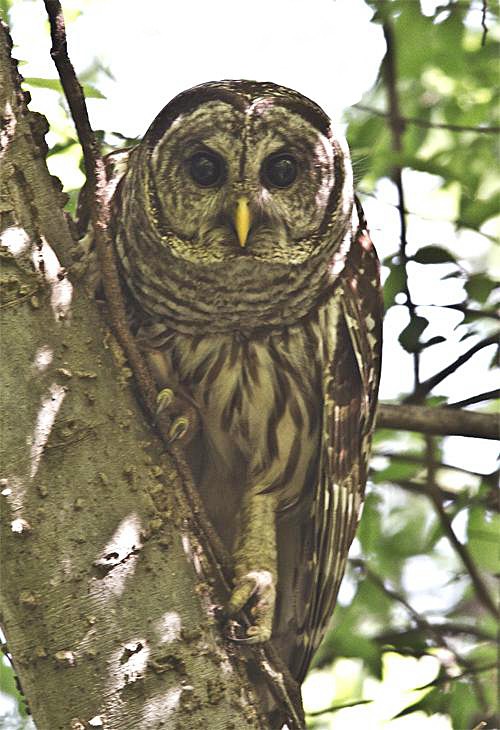
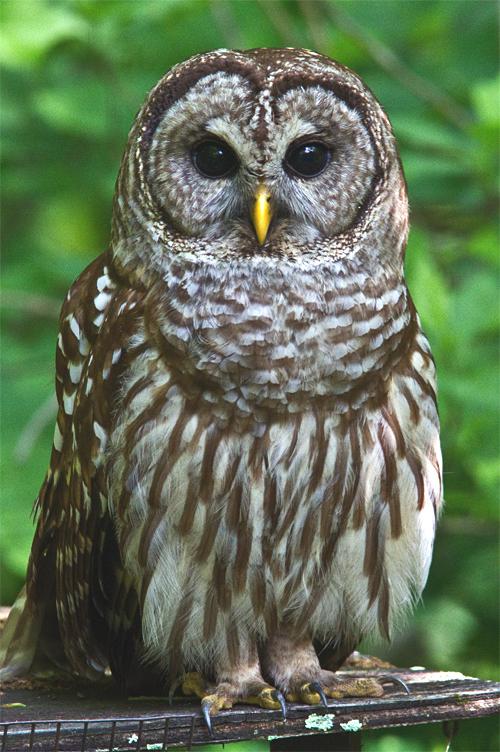
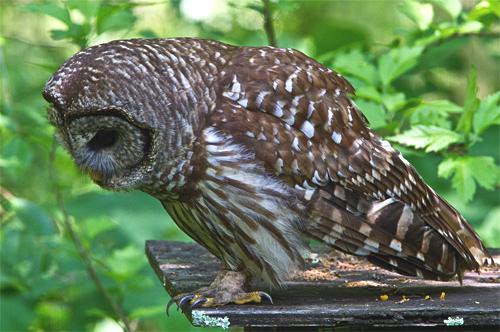
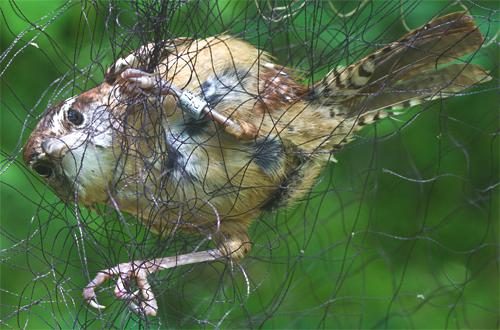
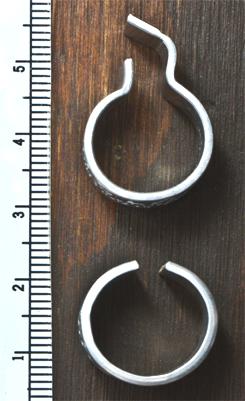 .
. 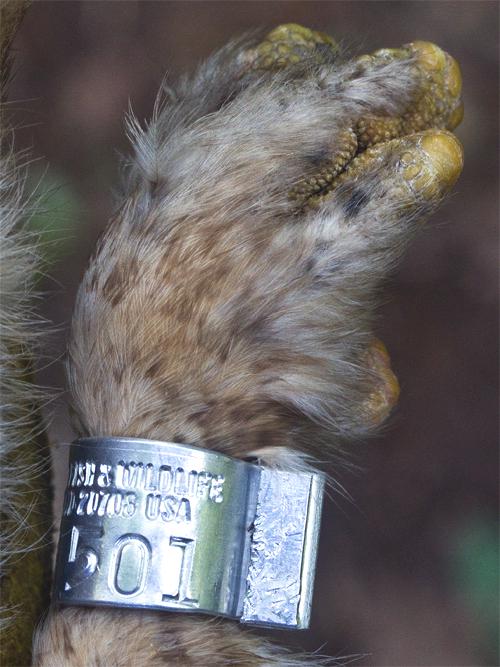
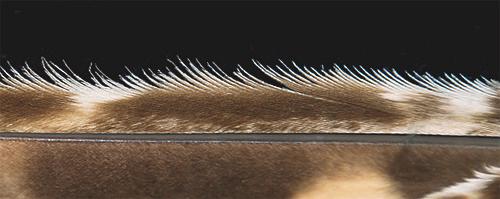
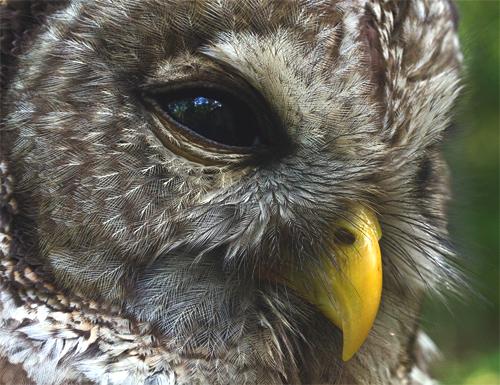

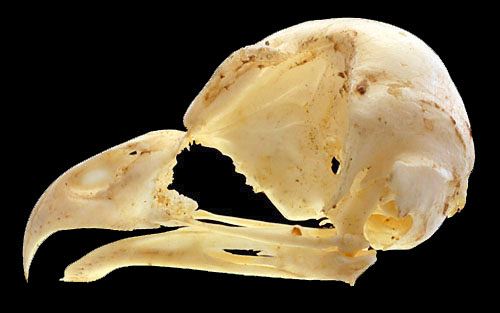
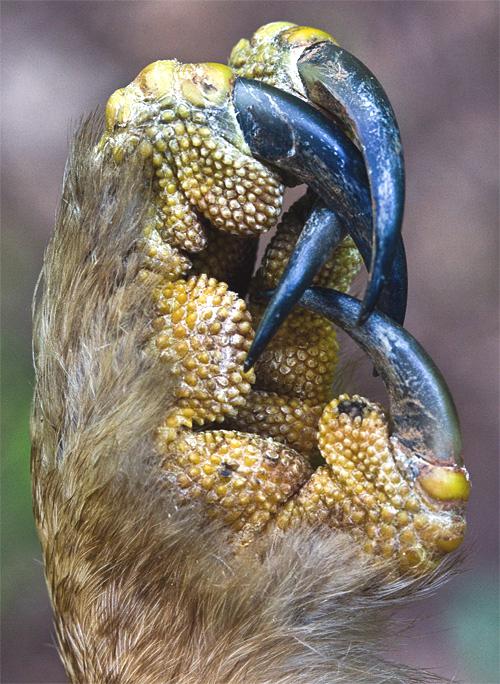
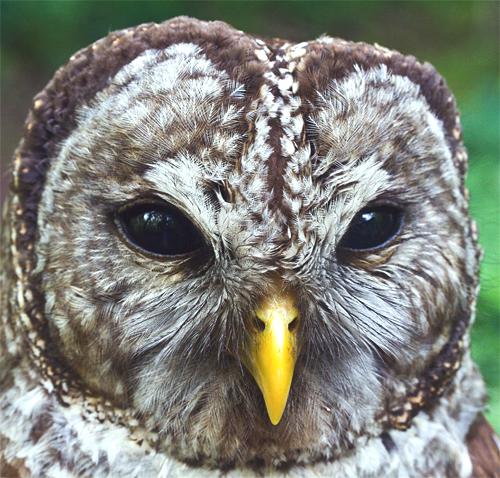
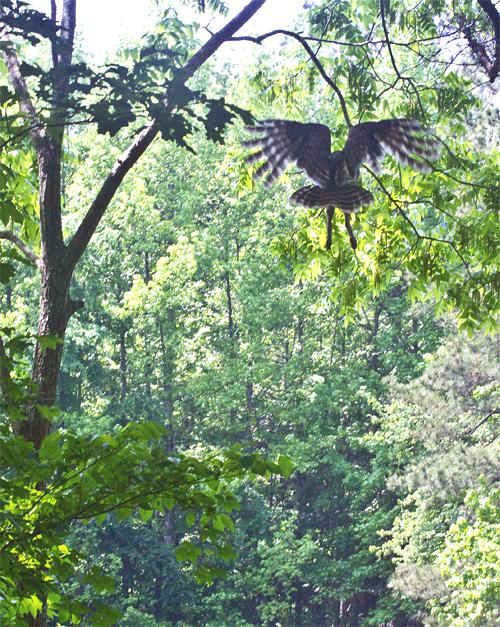


 Please report your sightings of
Please report your sightings of